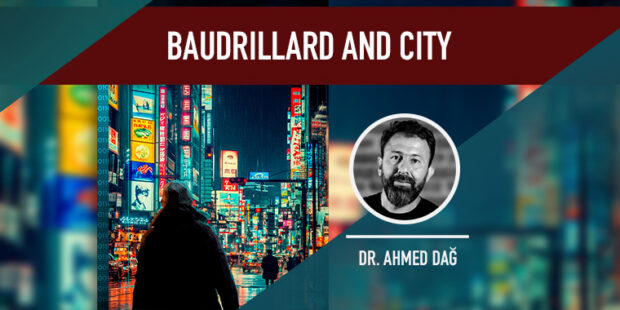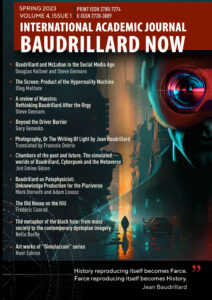
Baudrillard and City
by Dr. Ahmed Dağ
The process of making law or science started with the rationalist-empiricist synthesis of the 17th century during the Enlightenment (18th century) that replaced tradition and religion after Bacon, who aimed to dominate nature and society with the discourse of “knowledge is power.” According to Baudrillard who had a critical approach to the roots of Enlightenment in the West intersecting with the Baconian approach, Cartesian mathematics, and Newtonian physics, nature in Western thought is nothing but a concept of a dominated essence that is claimed to replaced and reproduced by science and technology.
“Naturalistic” ideological understanding presents itself in the construction of the city. Nature has been perceived all over the World as a social model since its emergence as a concept resembling décor or a structure model. Everything from a building to a small spoon or a city as a whole has been called an “object” following the emergence of an object-based approach in urban architecture based on the “naturalist” understanding. Asserting that the “naturalist” ideology has gained an objective, universal, and functional meaning in architecture thanks to Bauhaus, Baudrillard states that we are living in a universe where everything carries the qualification of a function and a sign. There is an unsystematic revolution devoid of a unique status based on objects and a rational goal (functionality).
The world-city that formed against the countryman built cosmopolitanismin place of “home.” Civilization, which is the state of advanced humanity, is an external and artificial state. Those living in such aworld-city do not make up a community but a crowd. In this case, they are death following life, rigidity following expansion, the intellectual age and the stone-built, petrifying world-cities following Mother Earth and the spiritual childhood of the Doric and Gothic. Cities are the constructs of civilization, whereas madīnahs are the constructs of ḥaḍārah. Western cities carry the attributes of civilization, whereas Islamic cities carry the attributes of ḥaḍārah. While the European city design or Weber’s city has a class “encounter,” there is a corporate structure at the center of the community in the Islamic madīnah “equalizing” the people. The landon which the population is increasing becomes the property of mankind, petrifying over time into a city. During this process, urbanization, or petrification, is indispensable, and the humans belonging to the city they own become a part of it and are there by being affected by its character. According to Baudrillard, it is not space but time that determines whether an individual belongs to the city. Indeed, it was time and not space that was indicative during the Middle Ages and the Renaissance.
The spirit of the times (zeitgeist) affected and identified the people living during those times. While time identified the people, they in turn determined the madīnah of the time they lived in together with space. In this context, the 19th- and 20th-century-city was the perfection of modern space. It was the space of rationality and of industry, liberalism, and advancement. New architecture created a new community independent of the social, aesthetic, and philosophical accumulation of the 20th century. Modern madīnahs that are generally located at the center of large empires have resultedin a contrast between the madīnah and village, the urban and rural, and the modern and passé. Attempts were made to depict and understand these contrasts, paradoxes, and rootlessnesses during the beginning of the 20th century by C. Baudelaire and G. Simmel and towards the end of the century by J. Baudrillard. To observe modern space, Baudelaire uses the flâneur, the citystroller, a modern person who does not participate in the city but is an ambivalent observer.
The flâneur perceives the metropolis as acharming world of dreams, a cradle of modern living culture that is “the center of sparkling night life. The modern man and flâneur of Baudelaire and Baudrillard, are different from one another. Baudrillard’s flâneur is glued to the seat in front of the TV screen; the leisurely wanderer is strolling no more. Now it is the TV images, advertorials, commodities, and various pleasures that stroll and wander opposite the hypnotized viewer. Baudelaire’s leisurely wanderer has transformed into Baudrillard’s viewer. In his article entitled “The Metropolis and Mental Life” (1903), Simmel presents various snapshots of life in the metropolis. The subject is the modern metropolitan individual with an intensified emotional life subject torapid and ever-changing internal and external stimuli. Similar to Simmel, Baudrillard focused on the McDonaldization and Disneyfication of time in his book Simulations (1983) and proposed a whole new perspective on modern life in the metropolis with the concept of hyper-reality.
Urban planning of the private sector and its understanding of development, order, and administration has taken the place of the madīnah in the feudal order. The city has been built in this framework, as a result of which the elite and middle class that make up urban colonialism emerged. Baudrillard, examines this emerging postmodern city: The urban city is also a neutralized, homogenized space, a spacewhere indifference, the segregation of urban ghettos, and the downgrading of districts, races, and certain age groups are on the increase. In short, it is the cut-up space of distinctive signs. Multiple codes assign a determinate space-time to every act and instant of everyday life. The racial ghettos on the out skirts or in the city centerare only the limit expression of this urban configuration: an immense center for marshalling and enclosure where the system reproduces itself not only economically and spatially, but also in depth by theramifications of signs and codes, by the symbolic destruction of social relations. The capitalized city is like an entity that is growing every day. People rush to these cities that are constructed on the mind-bodyduality. In the language of economics, it is almost as if an excessiveamount of product/spirit is introduced to the market/society. Cities built by Cartesian thought are populated not only by bodies but alsoby excessive amounts of information, informatics, communication, and social networks. The city is a location people rush towards as a center of attraction. The city is the location of this increase and “chainreaction” approved by the holistic dictatorship of fashion. The intensive urbanization process of rural areas via rapid acculturation isirrecoverable and unstoppable. The discourses of the city (impulses, desires, stimulations, judgments, eroticization, information, stimulation of advertisements) are as determinant with regard to the fate of the society as is the population density of the city.
J. Nouvel, who conducted an interview with Baudrillard stating that it isnot possible to prevent the growth of the city and urbanization, claims that the rush towards cities leads to a sort of urban big bang by enabling the making of plans and the placing of rules; hence, ready recipes and architecture have now become futile, indicating that the system becomes absurd as soon as it is combined with a structural model. Urbanization has brought about rapid modernization leading to the desertification of the country by dehumanizing villages and rural areas. Speed and growth have resulted in an increase in the number of cities as well as urbanization. The discourses of the city have led to individuals focused on speed and desire and the fast cities built by these individuals. The term fastcitiesis used to define rapidly growing or, in other words, economically booming cities. Reference is made to their growth centered on trade and economy. Such cities characterized by innovation, entrepreneurship or fast economy and spatial grow the express the success story of global neo-liberal urbanism.
Asserting that architecture operating by way of a piece of land/territory to take shelter in and to defend will always have a placefor itself even when the forms of civilization change, Baudrillard suggests that architectural acts as sources of pleasure that are inrelation with new data will always be present despite the assumption that the city has disappeared both physically and territorially. As proposed by Baudrillard, the city and architecture will continue their presence for as long as there are people and lands. However, the city takes on a different form together with architecture. In this context, Baudrillard indicates that large urban areas developing in an unplanned manner have been captured during the last two decades mostly by artists and the bourgeoisie, who have changed the life andappearance of neighborhoods. According to him, this situation leads to a negative-ironic question: “Now, is this rehabilitation or a mutation?” He suggests that we witness the changes in cities asentities that move in time, which in the end acquire some sort of singularity as well as the erosion of their character.
This article builds on a previously published piece featured in Ilahiyat Studies (https://ilahiyatstudies.org/journal/article/view/642
References
Baudelaire, C. (1964). The Painter of Modern Life and Other Essays. Trans. Jonathan Mayne, Phaidon Press.
Baudrillard, J. (2011). Impossible exchange. New York: Verso.
Baudrillard, J. (1975). The Mirror of Production, trans. Mark Poster, St. Louis, MO: Telos Press.
Baudrillard, J. (1981). For a Critique of the Political Economy of the Sign, trans. Charles Levin, St. Louis, MO: Telos Press.
Baudrillard, J. The Consumer Society: Myths & Structures, London:SAGE Publications.
Baudrillard J. and J. Nouvel (2002). The Singular Objects of Architecture, trans. R. Bononno Minneapolis: University of Minnesota Press.
Bergen, B. (2016). Kenti Durduran Şehir, Ankara: MGV.
Dağ, A. (2011). Ölümcül Şiddet: Baudrillard’ın Düşüncesi, İstanbul: Külliyat.
Richard J.l. (2000). Jean Baudrillard, London: Routledge.
Spengler, O. (1929). The Decline of the West Vol. I: Form and Actuality, trans. C. F. Atkinson London: George Allen & Unwin Ltd., 31-33.
Discover more from BAUDRILLARD NOW
Subscribe to get the latest posts sent to your email.


